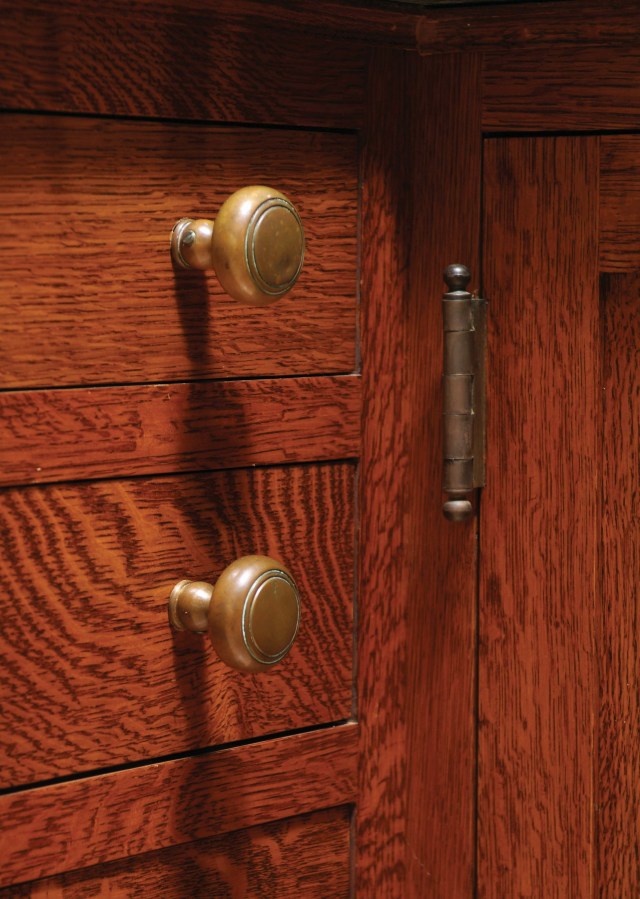
If you had told me in 2007 that Lost Art Press was going to publish a book on kitchens, my 2007 self would have been skeptical. Kitchen books are usually put out by imprints that specialize in home and interior design. They require both a deep knowledge of the topic, plus a deep photographic well of example kitchens.
Plus these books encourage readers to be shamefully wasteful: Let’s rip out your five-year-old kitchen and put in a spectacular new one.
After talking to Nancy Hiller for a few minutes about her thoughts on a kitchen book, however, I was immediately sold. Nancy laid out a book that was in opposition to most kitchen design books on the market.
• She encourages you to explore clues in your house to create a kitchen that looks correct in your home’s historical context.
• She shows how you can work with existing floorplans, cabinets and materials to make your kitchen beautiful without sending hundreds of yards of waste to the landfill.
• And she provides professional and practical information on how you can do this work yourself.
“Kitchen Think” is the culmination of Hiller’s life as a professional furniture maker, cabinet maker and kitchen designer. It’s a sprawling, 369-page look at an important (and expensive) room in your house from a perspective that is rarely heard.
And readers have responded to Nancy’s voice. Though the book has been out since only June 2020, it has become one of our bestselling books of all time (see the list here). If you have been thinking about ripping out your entire kitchen, you might want to think again.
— Christopher Schwarz
/*<![CDATA[*/
(function () {
var scriptURL = 'https://sdks.shopifycdn.com/buy-button/latest/buy-button-storefront.min.js';
if (window.ShopifyBuy) {
if (window.ShopifyBuy.UI) {
ShopifyBuyInit();
} else {
loadScript();
}
} else {
loadScript();
}
function loadScript() {
var script = document.createElement('script');
script.async = true;
script.src = scriptURL;
(document.getElementsByTagName('head')[0] || document.getElementsByTagName('body')[0]).appendChild(script);
script.onload = ShopifyBuyInit;
}
function ShopifyBuyInit() {
var client = ShopifyBuy.buildClient({
domain: 'lost-art-press-test.myshopify.com',
storefrontAccessToken: 'f83226aac752f3a8e262f8a8273c9739',
});
ShopifyBuy.UI.onReady(client).then(function (ui) {
ui.createComponent('product', {
id: '4655025913919',
node: document.getElementById('product-component-1633948543977'),
moneyFormat: '%24%7B%7Bamount%7D%7D',
options: {
"product": {
"styles": {
"product": {
"@media (min-width: 601px)": {
"max-width": "calc(25% – 20px)",
"margin-left": "20px",
"margin-bottom": "50px"
}
},
"button": {
"font-size": "14px",
"padding-top": "15px",
"padding-bottom": "15px",
"border-radius": "11px",
"padding-left": "22px",
"padding-right": "22px"
},
"quantityInput": {
"font-size": "14px",
"padding-top": "15px",
"padding-bottom": "15px"
}
},
"text": {
"button": "Add to cart"
}
},
"productSet": {
"styles": {
"products": {
"@media (min-width: 601px)": {
"margin-left": "-20px"
}
}
}
},
"modalProduct": {
"contents": {
"img": false,
"imgWithCarousel": true,
"button": false,
"buttonWithQuantity": true
},
"styles": {
"product": {
"@media (min-width: 601px)": {
"max-width": "100%",
"margin-left": "0px",
"margin-bottom": "0px"
}
},
"button": {
"font-size": "14px",
"padding-top": "15px",
"padding-bottom": "15px",
"border-radius": "11px",
"padding-left": "22px",
"padding-right": "22px"
},
"quantityInput": {
"font-size": "14px",
"padding-top": "15px",
"padding-bottom": "15px"
}
},
"text": {
"button": "Add to cart"
}
},
"option": {},
"cart": {
"styles": {
"button": {
"font-size": "14px",
"padding-top": "15px",
"padding-bottom": "15px",
"border-radius": "11px"
}
},
"text": {
"total": "Subtotal",
"button": "Checkout"
}
},
"toggle": {
"styles": {
"count": {
"font-size": "14px"
}
}
}
},
});
});
}
})();
/*]]>*/
The following is excerpted from “Kitchen Think,” by Nancy R. Hiller.
Hinges are more than a means of hanging doors. They contribute significantly to a kitchen’s look. In principle you can use any type of hinge for kitchen cabinet doors, but this section will focus on those that are most common.
Butt Hinges
Doors on traditional kitchen cabinets were inset and typically hung on butt or butterfly hinges. Let’s start with the former. Butt hinges come in several varieties. There are extruded brass butts (known in Britain as solid drawn brass butts) with fixed pins and loose-pin butts that allow you to separate a door from its cabinet by simply removing the pin, leaving the hinge leaves in place. All traditional butt hinges are made to be mortised into the edge of the face frame (if there is one) and door, though in British cabinetry it is not uncommon to find them let only into the door; in these cases the cabinet leaf is simply screwed to the face frame stile.
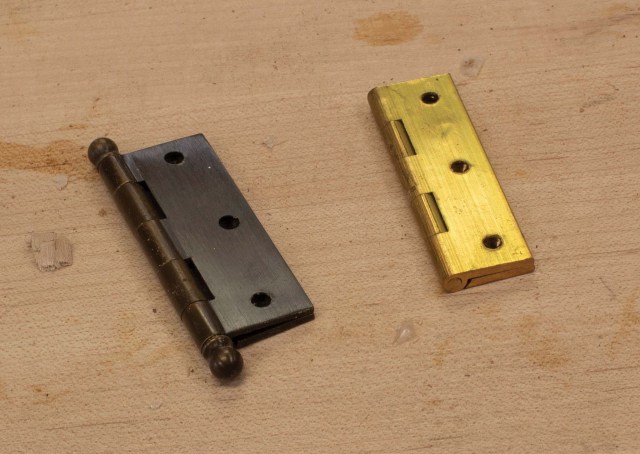
Alternatively, you can use salvaged architectural hinges that were originally made for use with full-size house doors. Yes, they’re over-sized for most kitchen cabinets, but there are times when this kind of exaggerated scale packs a stylistic punch that no conventionally sized hardware can.
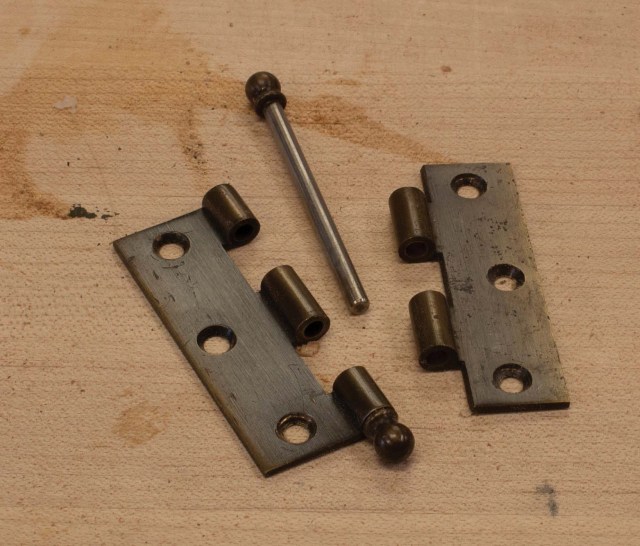
Another kind of butt is the adjustable, no-mortise hinge. This hinge is designed to resemble a traditional butt, with or without decorative finials, but is screwed to the surface of the door and face frame, the idea being that it is far quicker to install and requires fewer tools and lesser skill. The drawback, at least in my opinion, is that these hinges are a poor imitation of real butts; they look under-scaled. And to any craftsperson, they suggest an easy way out. That said, they do offer a relatively decent traditional butt hinge look and can make a set of cabinets significantly more affordable when the client or homeowner is on a tight budget.
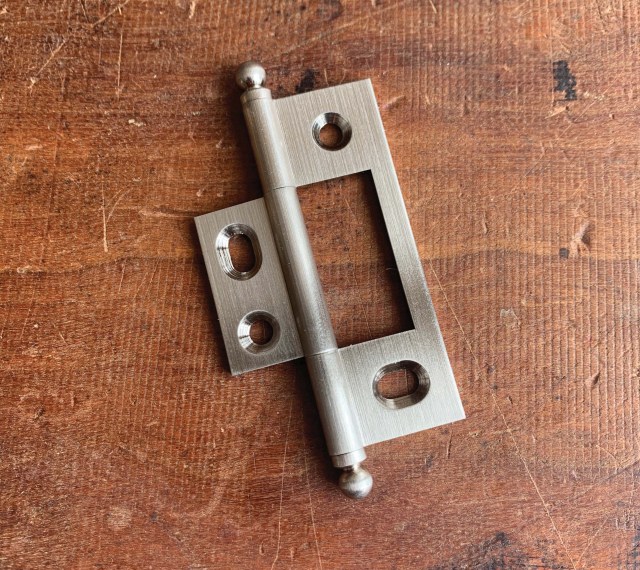
Butterfly Hinges
In the early 20th century, as companies turned out large numbers of cabinets, it became clear that inset doors came with their own built-in problems, the greatest being that they require a bit of skill to install well. On any cabinetry supplied with doors already hung – Hoosier cabinets are an ideal example – the tendency of doors to bind when cabinets were delivered to real-world locations became an even more pressing issue; the cabinets were sold with the claim that they were readily affordable and ready to use. So it was not surprising to me, as a cabinetmaker, to find in the course of my research on Hoosier cabinets that the largest manufacturer of these kitchen furnishings pretty quickly switched to half-inset (also known as half-overlay) doors. They marketed this as an improvement on the grounds that the resulting lip would keep dust from getting into the cabinet through the gaps in traditional inset doors.
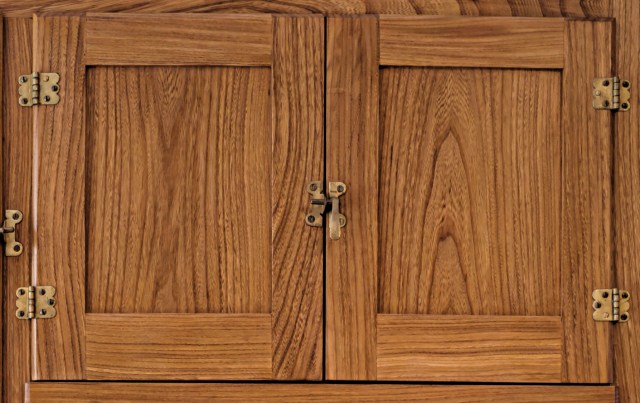
Butterfly hinges have been used since the 19th century, if not before, and were widely used into the 1930s. Their popularity comes and goes with changes in decorating fashions. For a decade or so in the early 2000s there was a wide range of designs and finishes available, but ever since mid-century modern became the new “it girl” and gave “old-house” styles the boot, those of us who appreciate early 20th-century architecture have been reduced to choosing from a few reproduction designs offered by reputable manufacturers. One solution to this diminished variety is to look for antique hinges at salvage yards, antique shops and online.
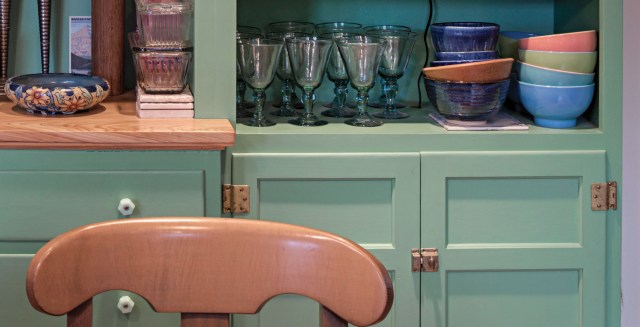
A variant on the older-pattern butterfly hinge is the offset butterfly hinge, designed for use with half-inset doors. And there are other variants on this one, some Art Deco-inspired, others the fold-back hinges used on certain Hoosier-type cabinets.
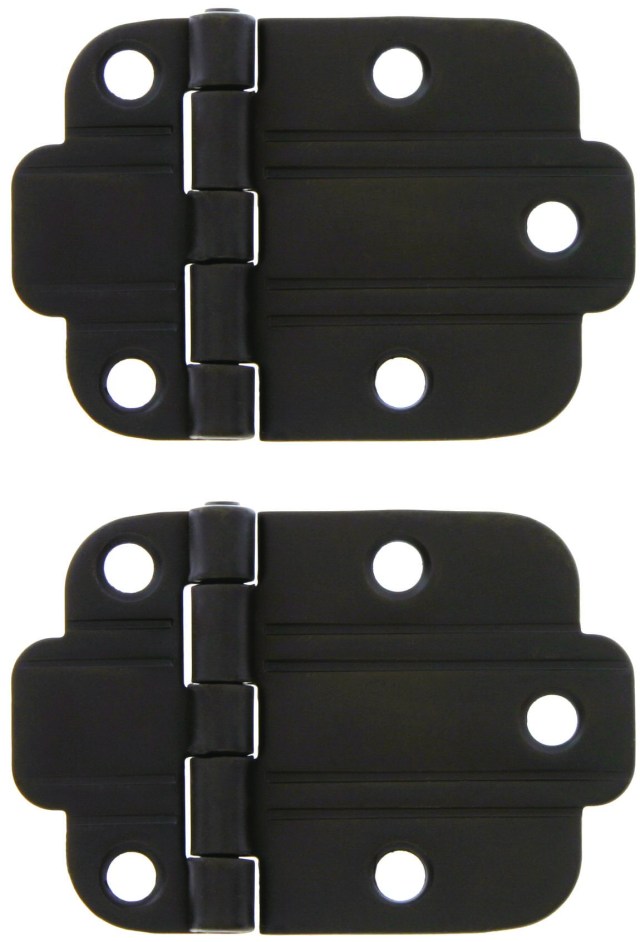
3/8″ Inset Hinges
From the mid- through late-20th century another type of hinge was widely used for kitchen doors. The “3/8″ inset” hinge came (and is still available) in a few patterns, the most distinctive being a sort-of bullet/streamline design. This type of hinge is available in free- or self-closing forms. It is extremely simple to install, with one caveat: You must allow enough space in the rabbet around the door’s perimeter to account for the distance by which the hinge will push the hinge stile away from the face frame. The only circumstances in which I would recommend using these hinges today are when replacing a broken hinge or adding new doors to an existing kitchen full of cabinets hung on them or, of course, if you are recreating a period-authentic kitchen in movie set or a house that originally had them.
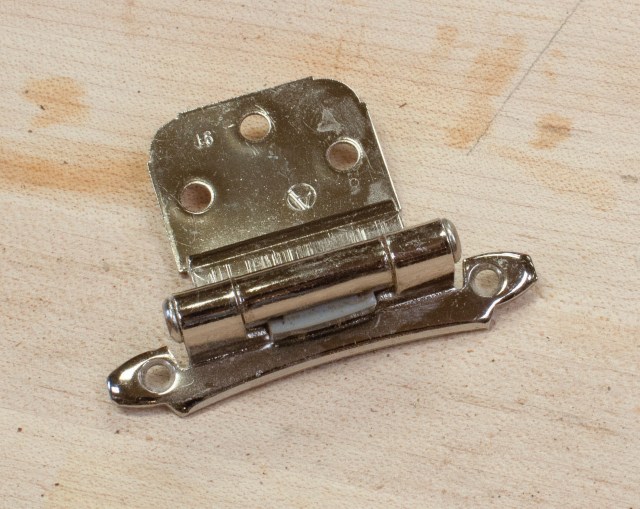
European Hinges
European hinges were designed for use with European-style cabinets, also known as frameless cabinets. Underlying this system of cabinet building and installation is a desire to maximize efficiency by standardizing components based on 32mm (approximately 1-3/8″) increments.
European hinges come in a vast variety, each designed to work in a different application. Even so, most consist of just two basic parts – a hinge and a mounting plate.
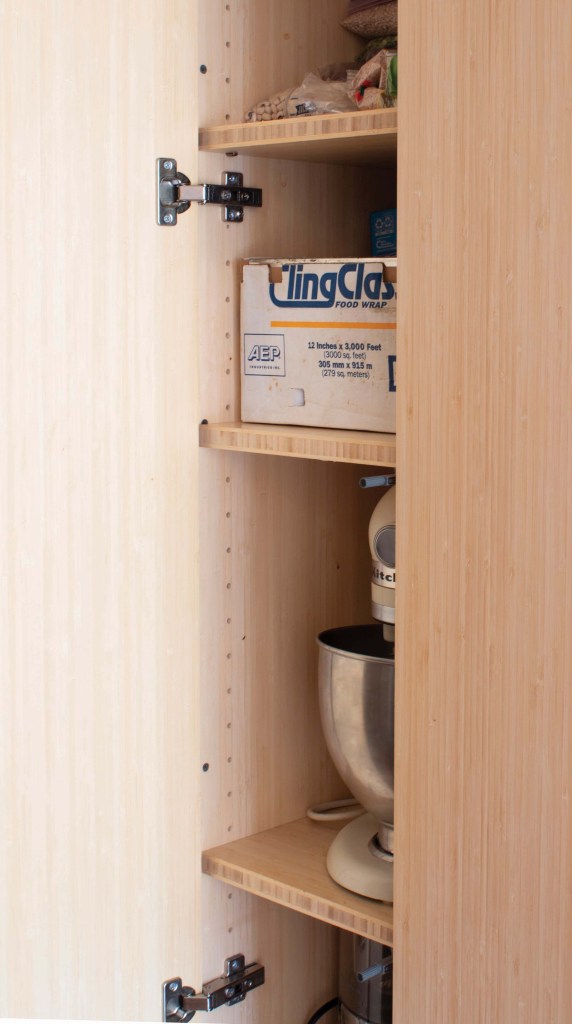
To make a simple matter slightly less so, European hinges also come in a variety specifically designed for use on cabinets with face frames; these have an integral mounting plate. But you don’t have to use this “face frame” hinge to use European hinges on cabinets with face frames; you can just as well use the two-part variety, provided that you choose the correct combination of hinge and mounting plate for your application.
Depending on which combination of hinge and mounting plate you use, these hinges can work with doors that are inset, half-inset or full overlay. And there are even more variations! A full-overlay door may overlay the cabinet face by 1/4″ or 1-1/4″, depending on the mounting plate you use. Doors can open 95° or as much as 165°. They can be free closing (these do not hold themselves closed but require a catch) or self-closing. Some are even available with a soft-close feature that shuts the door for you once you give it a gentle push. (Aside from their undeniable coolness, these are useful for keeping children from slamming their fingers in cabinets.)
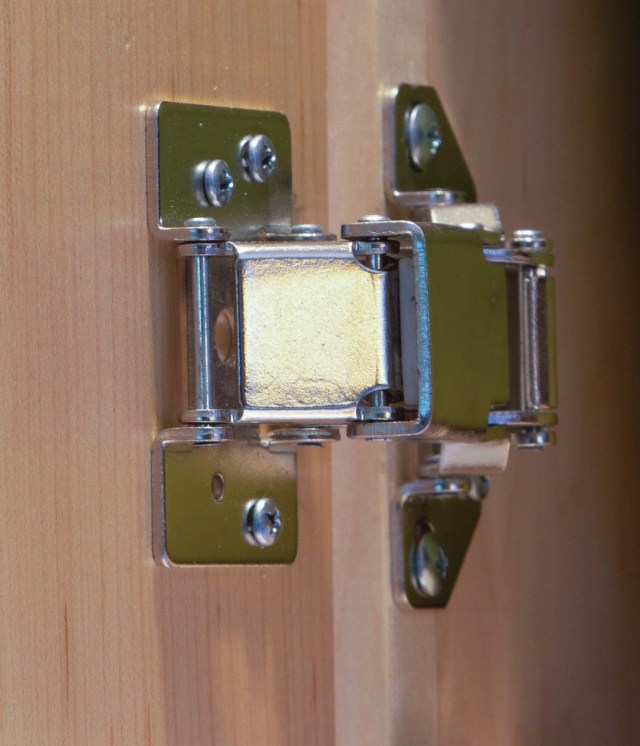
Despite the huge variety, all of these hinges have the same pattern for drilling the hinge cup mortise in the door: a hole drilled to the depth of the cup (about 1/2″) with a 35mm Forstner bit.
There are two good reasons to choose European hinges in select applications. First, being invisible when a door is closed, they offer a clean look. If not seeing the hinges is important to your design, these may be your guys. Second, they offer adjustability in three planes, which makes fitting any kind of door – inset, half-inset or full overlay – ridiculously simple compared to using traditional butt hinges.
Specialty Hinges
If knife hinges are your thing, there’s no reason why you can’t use those or any other type of hinge less commonly used for kitchen cabinets. In some applications where none of the conventional options will work, you just have to go looking for a special hinge.
/*<![CDATA[*/
(function () {
var scriptURL = 'https://sdks.shopifycdn.com/buy-button/latest/buy-button-storefront.min.js';
if (window.ShopifyBuy) {
if (window.ShopifyBuy.UI) {
ShopifyBuyInit();
} else {
loadScript();
}
} else {
loadScript();
}
function loadScript() {
var script = document.createElement('script');
script.async = true;
script.src = scriptURL;
(document.getElementsByTagName('head')[0] || document.getElementsByTagName('body')[0]).appendChild(script);
script.onload = ShopifyBuyInit;
}
function ShopifyBuyInit() {
var client = ShopifyBuy.buildClient({
domain: 'lost-art-press-test.myshopify.com',
storefrontAccessToken: 'f83226aac752f3a8e262f8a8273c9739',
});
ShopifyBuy.UI.onReady(client).then(function (ui) {
ui.createComponent('product', {
id: '4655025913919',
node: document.getElementById('product-component-1633948543981'),
moneyFormat: '%24%7B%7Bamount%7D%7D',
options: {
"product": {
"styles": {
"product": {
"@media (min-width: 601px)": {
"max-width": "calc(25% – 20px)",
"margin-left": "20px",
"margin-bottom": "50px"
}
},
"button": {
"font-size": "14px",
"padding-top": "15px",
"padding-bottom": "15px",
"border-radius": "11px",
"padding-left": "22px",
"padding-right": "22px"
},
"quantityInput": {
"font-size": "14px",
"padding-top": "15px",
"padding-bottom": "15px"
}
},
"text": {
"button": "Add to cart"
}
},
"productSet": {
"styles": {
"products": {
"@media (min-width: 601px)": {
"margin-left": "-20px"
}
}
}
},
"modalProduct": {
"contents": {
"img": false,
"imgWithCarousel": true,
"button": false,
"buttonWithQuantity": true
},
"styles": {
"product": {
"@media (min-width: 601px)": {
"max-width": "100%",
"margin-left": "0px",
"margin-bottom": "0px"
}
},
"button": {
"font-size": "14px",
"padding-top": "15px",
"padding-bottom": "15px",
"border-radius": "11px",
"padding-left": "22px",
"padding-right": "22px"
},
"quantityInput": {
"font-size": "14px",
"padding-top": "15px",
"padding-bottom": "15px"
}
},
"text": {
"button": "Add to cart"
}
},
"option": {},
"cart": {
"styles": {
"button": {
"font-size": "14px",
"padding-top": "15px",
"padding-bottom": "15px",
"border-radius": "11px"
}
},
"text": {
"total": "Subtotal",
"button": "Checkout"
}
},
"toggle": {
"styles": {
"count": {
"font-size": "14px"
}
}
}
},
});
});
}
})();
/*]]>*/